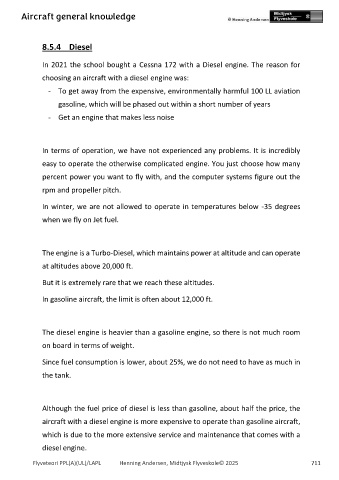Page 711 - PPL-engelsk 2025
P. 711
Aircraft general knowledge
8.5.4 Diesel
In 2021 the school bought a Cessna 172 with a Diesel engine. The reason for
choosing an aircraft with a diesel engine was:
- To get away from the expensive, environmentally harmful 100 LL aviation
gasoline, which will be phased out within a short number of years
- Get an engine that makes less noise
In terms of operation, we have not experienced any problems. It is incredibly
easy to operate the otherwise complicated engine. You just choose how many
percent power you want to fly with, and the computer systems figure out the
rpm and propeller pitch.
In winter, we are not allowed to operate in temperatures below -35 degrees
when we fly on Jet fuel.
The engine is a Turbo-Diesel, which maintains power at altitude and can operate
at altitudes above 20,000 ft.
But it is extremely rare that we reach these altitudes.
In gasoline aircraft, the limit is often about 12,000 ft.
The diesel engine is heavier than a gasoline engine, so there is not much room
on board in terms of weight.
Since fuel consumption is lower, about 25%, we do not need to have as much in
the tank.
Although the fuel price of diesel is less than gasoline, about half the price, the
aircraft with a diesel engine is more expensive to operate than gasoline aircraft,
which is due to the more extensive service and maintenance that comes with a
diesel engine.
Flyveteori PPL(A)(UL)/LAPL Henning Andersen, Midtjysk Flyveskole© 2025 711

